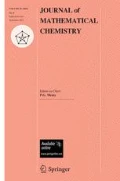Abstract
The relations of caterpillar trees (which are also known as Gutman trees and benzenoid trees) to other mathematical objects such as polyhex graphs, Clar graphs, king polyominos, rook boards and Young diagrams are discussed. Potential uses of such trees in data reduction, computational graph theory, and in the ordering of graphs are considered. Combinatorial and physical properties of benzenoid hydrocarbons can be studied via related caterpillars. It thus becomes possible to study the properties of large graphs such as benzenoid (i.e. polyhex) graphs in terms of much smaller tree graphs. Generation of the cyclic structures of wreath and generalized wreath product groups through the use of caterpillar trees is illustrated.
Similar content being viewed by others
References
F. Harary and A.J Schwenk, Discrete Math. 6 (1973)359.
Ref. [1],p. 361.
F. Harary and A.J. Schwenk, Mathematika 18 (1971)138.
F. Harary and A.J. Schwenk, Utilitas Math. 1 (1972)203.
I. Gutman, Theor. Chim. Acta 45 (1977)309.
S. El-Basil, J. Chem. Soc., Faraday Trans. 2, 82 (1986)299.
S. El-Basil, Theor. Chim. Acta 65 (1984)199.
S. El-Basil, Theor. Chim. Acta 65 (1984)191.
Ordering of structures has been explicitly considered in both the mathematical and chemical literature. Thus, J.F. Nagle, J. Math. Phys. 7(1966)J88. considered a general linear ordering relation for graphs with the same number of vertices, while E. Ruch, Theor. Chim. Acta 38(1975)167, considered ordering of Young diagrams. M. Randić and C.L. Wilkins, Chem. Phys. Lett. 63(1979)332; J. Phys. Chem. 83(1979)1525, considered ordering of alkanes and how it reflects on their physical properties.
Here, the termdata reduction means studying the properties of a large molecule in terms of those of a smaller one (see refs. [4041]).
The term polyhex graphs means the molecular graph of a benzennid hydroearbon. This term was bu used in: N. Ohkami. A. Motoyama, T. Yamaguchi, H. Hosoya and I. Gutman,Tetrahedron 37(1981)1113.
A recent account mar be found in: N. Trinajstić,Chemical Graph Theory, Vol. 2 (CRC Boca Raton, Florida, 1983)
Cf. H. Sachs,Combinatozioa4, 1 (1984)89.
C. Domb and M.S. Green,Phase Transitions and Critical Phenomena, Vols. 1–3, ed. M.S. Green (Academic Press, London, 1972).
I. Gutman, Z. Naturforsch. a37 (1982)69.
I. Gutman and S. EI-Basil, Z. Naturforsch. a39 (1984)276.
Line graphs are defined in: F. Hamry,Graph Theory (Addison-Wesley, Reading, 1969)Ch. 8.
King polyomino graphs were first defined in: A. Motoyama and H. Hosoya, J. Math. Phys. 18 (1977)1485.
Cf. C.D. Godsil and I. Gutman, Croat. Chem. Acta 54 (1981)53.
A bipartite graph (bigraph bicolarable graph)G is a graph whose vertex setV can be partitioned into two subsetsV 1 andV 2 such that every line ofG joinsV 1 withV 2 (see ref. [14], p. 17).
D. Hosoya, Bull. Chem. Soc. Japan 44 (1971)2332.
H. Hosoya and T. Yamaguchi, Tetrahedron Lett. (1975) 4659.
N. Ohkami and H. Hosoya, Theor. Chim. Acta 64 (1983)153.
Generating functions are defined in books on combinatorics: V. Krishnamurthy,Combinatorics: Theory and Applications (E. Horwood, New York, Halsted Press, 1986). The sextet polynomial [21] is a very special form of generating functions which generate all possible ways in which one can perfectly match [10] the edges of a polyhex graph [8].
A recent generalized approach to structure count is found in: B. Ruščić, N. Trinajstić and P. Křivka, Theor. Chim. Acta 69 (1986)107.
One of the earliest works pertaining to chemical combinatorics is that of: M. Gordon and W.T. Davison, J. Chem. Phys. 20 (1952)428.
Proper and improper sextets are defined in ref. [22] .
H. Hosoya and N. Ohkami, J. Comput. Chem. 4 (1983)585.
E. Heilbronner, Helv. Chim. Acta 36 (1953)171.
Details of some aspects of Clar sextet theory may be found in: I. Gutman, Bull. Soc. Chim. Beograd 47 (1982)453.
J. Aihara, Bull. Chem. Soc. Japan 49 (1976)1429.
A0 “Dewar-type” resonance theory depends on the concept of a reference structure: M.J.S. Dewar and C. de Llano, J. Amer. Chem. Soc. 91 (1969)789.
I. Gutman, Croat. Chem. Acta 56 (1983)365.
M. Randić, J. Amer. Chem. Soc. 99 (1977)444; Tetrahedron 33(1977)1905.
W.C. Herndon and M.L. Ellzey, Jr., J. Amer. Chem. Sac. 96 (1974)6631.
K. Balasubramanian and M. Randić, Theor. Chim. Acta 61 (1982)307; see also K. Balasubramanian, Int. J. Quantum Chem. 22(1982)581.
I. Gutman and M. Randić, Chem. Phys. Lett. 47 (1977)15.
G.H. Hardy, J.E. Littlewood and G. Pólya,Inequalities (Cambridge University Press, London, 1934) p. 44.
E. Ruch, Theor. Chim. Acta 38 (1975)167; E. Ruch and A. Schönhofer, Theor. Chim. Acta 19(1970)225.
A. Smolenskii, Russ. J. Phys. Chem. (English translation) 38 (1964)700.
M. Gordon and J.W. Kennedy, J. Chem. Soc., Faraday Trans. 2, 68 (1972)484.
A.T. Balaban and F. Harary, Tetrahedron 24 (1968)2505.
S. El-Basil, Chem. Phys. Lett. (1987), in press.
M. Randić, J. Amer. Chem. Soc. 97 (1975)6609.
F. Harary,Graph Theory (Addison-Wesley, Reading, 1969) p. 164.
K. Balasubramanian, Chem. Rev. 85 (1985)599; and numerous references cited therein.
G. Pólya, Acta Math. 65 (1937)145.
K. Balasubramanian, Studies in Physical and Theoretical Chemistry 23 (1982)149.
K. Balasubramanian, Theor. Chim. Acta 51 (1979)37.
Author information
Authors and Affiliations
Rights and permissions
About this article
Cite this article
El-Basil, S. Applications of caterpillar trees in chemistry and physics. J Math Chem 1, 153–174 (1987). https://doi.org/10.1007/BF01205666
Received:
Issue Date:
DOI: https://doi.org/10.1007/BF01205666




